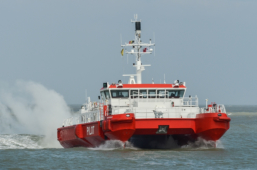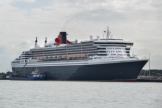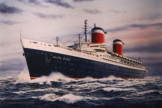© 2025 Cruiseschepen in Antwerpen
All rights reserved -


What are those white spheres on top of cruise ships? How fast is a knot? What is the difference again between port and starboard?
On this page it will all be explained!
Nederlands
English
English
|
Maritime information
The bridge


Satellite dish

Lifeboats and liferafts
The place from where the ship is steered. Here you will find the
captain and the officers.
The
white
spheres
on
the
top
deck
of
a
cruise
ship
are
satellite
dishes
in
a
spherical
housing.
They
provide
television
and
radio
signals
on
board.
On
both
sides
of
the
ships
hang
yellow
or
orange
lifeboats
that
have
space
for
all
passengers
and
crew
members
on
board.
The
lifeboats
can
still
be
subdivided
in
‘normal
lifeboats’
and
‘tenders’.
A
tender
has
been
designed
in
such
a
way
the
it
can
be
used
to
transport passengers to the shore when a cruise ship has to anchor. It can be seen as a taxi.
Apart
from
the
lifeboats
there
are
also
liferafts
on
board
that
can
fit
a
minimum
of
25%
of
all
persons
on
the
vessel.
That
means
that
the
rescue
capacity
of
a
cruise
ship
is
a
quarter
bigger
than
the
total
number
of
people
on
board.
The
liferafts
are
stored
outside on deck in white plastic barrels that open when they make contact with water.



Funnel (& environmental efforts)
This
is
the
exhaust
of
the
ships’
engines.
Over
the
last
few
years
there
has
been
a
lot
of
media
attention
regarding
the
air
pollution
by
cruise
ships.
Although
the
impression
is
given
that
nothing
is
being
done
to
reduce
emissions
this
is
not
true.
The
emission
of
sulfer
dioxide
(SOx)
and
nitrogen
oxide
(NOx)
has
already
been
reduced
on
the
North
sea
and
the
Baltic
Sea
by
strict
regulations.
Apart
from
that
the
cruise
and
ferry
branch
is
also
experimenting
with
new
possible
fuels
like
LNG
and
hybrid-technology.
No
other
maritime
branch
is
this
progressive
in
this
search.
While
looking
at
environmental
pollution
one
should
also
not
excessively
focus
on
the
cruise
ships.
Currently
a
total
of
around
100.000
ships
are
sailing
around
the
world,
but
only
around
400
of
those
are
cruise
ships.

Mast
At
the
front
of
the
ship,
behind
the
bridge,
you
can
find
the
mast.
On
it
are
the
radars
and
several
flags.
The
mast
must
also
always
fly
the
flag
of
the
waters
the
ship
is
currently
in.
A
ship
that
is
on
its
way
to
Antwerp
will
exchange
the
Dutch
flag
for
the
Belgian
flag at the border.

Propellers or Azipods
Cruise
ships
can
be
propelled
in
two
ways.
There
can
be
made
use
of
one
or
more
static
propellers
behind
which
a
rudder
can
be
found.
This
is
the
classical
way
and
is
still
widely
used
by
ship
builders.
A
second
possibility
is
to
replace
the
propeller
and
the
rudder
by
an
Azipod.
This
is
a
propeller
that
is
able
to
turn
360°
which
makes
it
possible
to
steer
the
ship
directly
sideways.
When
the
Azipods
work
together
with
the
bow
thrusters
(propellers
at
the
front
of
the
ship)
it
is
possible
to
turn
the
ship
around
in
a
perfect circle.
The cruise ship

Bulbous bow / Bulb
The
bulbous
bow
or
bulb
can
be
found
at
the
front
of
the
ship,
right
below
the
water
surface.
It
is
a
spherical
projection
to
reduce
the
resistance
of
the
water
on
the
ship
while
it
sails.
A
ship
creates
a
bow
wave
on
its
own,
but
due
to
the
bulb
a
second
wave
is
created
right
in
front
of
the
first
one
which
cancels
out
the
first
one.
This
reduces
the
water
resistance
on
the
ship,
which
can
be
translated
in
using
less
fuel,
but
not
every
ship
has
a
bulb.
Older
ships
often
don’t
have
it
because
the
technique
did
not
yet
exist
when
they
were
built.
But
some
new
ships
are
also
built
without,
or
with
an
altered
bulb.
That
is
because
a
bulbous
bow
is
only
effective at certain speeds, which cannot always be maintained.















6

6

5

4

3

3

3


The bridge
Satellite dish
Lifeboat
Lifeboat/Tender
Liferaft
Funnel
Mast
Propeller
Azipod
Bulbous bow / Bulb
Port & Starboard
In
the
maritime
world
one
does
not
speak
of
left
and
right,
but
of
port
and
starboard.
Both
are
also
given a specific colour: red and green.
Port
=
Left
& Red
Starboard
=
Right
& Green


Andere maritieme termen
Pilots
A
pilot
is
a
specialist
of
a
specific
stretch
of
water.
Due
to
their
knowledge
and
experience
they
advise
captains
on
board
the
ship
about
the
speed,
heading,
currents,
etc.
That
way
it
is
made
sure
that
the
ships
can
reach
their
destination
without
a
problem.
Almost
all
large
sea
ships
are
obligated
to
have
at
least
one
pilot
on
board,
but
often
there
is
a
second
pilot
on
board
during
river
sailings.
The
reason
for
the
second
pilot
on
the
river
Scheldt
is
because
it’s
one
of
the
most
difficult
rivers
to
navigate
due
to
treacherous
currents and its many sandbanks. Apart from that it is also a very busy river.
At
sea
there
are
two
pilot
stations:
De
Wandelaar
in
the
West
and
Steenbank
in
the
East.
At
the
Scheldt
estuary in Flushing there is a third pilot station for ships that sail the river Scheldt.

Convert knots to km/h
1 kts
= 1,85 km/h
2 kts
= 3,70 km/h
3 kts
= 5,56 km/h
4 kts
= 7,41 km/h
5 kts
= 9,26 km/h
6 kts = 11,11 km/h
7 kts
= 12,96 km/h
8 kts
= 14,82 km/h
9 kts
= 16,67 km/h
10 kts = 18,52 km/h
11 kts
= 20,37 km/h
12 kts
= 22,22 km/h
13 kts
= 24,08 km/h
14 kts
= 25,93 km/h
15 kts = 27,78 km/h
16 kts
= 29,63 km/h
17 kts
= 31,48 km/h
18 kts = 33,34 km/h
19 kts
= 35,19 km/h
20 kts = 37,04 km/h
21 kts
= 38,89 km/h
22 kts
= 40,74 km/h
23 kts
= 42,60 km/h
24 kts
= 44,45 km/h
25 kts = 46,30 km/h
26 kts
= 48,15 km/h
27 kts
= 50,00 km/h
28 kts = 51,86 km/h
29 kts
= 53,71 km/h
30 kts = 55,56 km/h



Did you know?
The record for the fastest Ocean Liner is held by the
American ship SS United States.
In 1952 the ship crossed the Atlantic Ocean with an average
speed of 34,51 kts or 63,91 km/h. At that speed it took only 3
days, 12 hours and 12 minutes.


The top speed of modern cruise ships averages between 20
and 24 knots, but there are also exceptions to this rule. The
2003 built Ocean Liner RMS Queen Mary 2 can still get a
speed of 30 kts or 55,56 km/h.
In
the
maritime
world
the
speed
of
a
ship
is
not
expressed
kilometres
per
hour
(km/h),
like
it
is
the
case
with
cars
and
trains,
but
in
knots.
When
you
multiply
the
number
of
knots
x1,85 you get the speed in km/h.

Follow us on social media











